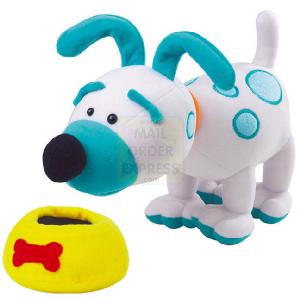This article is about playthings. For other uses of the term, see Toy (disambiguation).
A toy is an object used in play. Toys are usually associated with children and pets, but it is not unusual for adult humans and some non-domesticated animals to play with toys. Many items are manufactured to serve as toys, but items produced for other purposes can also be used as toys. A child may pick up a household item and 'fly' it around pretending that it is an airplane, or an animal might play with a pinecone by batting at it, chasing it, and throwing it up in the air. Some toys are intended primarily as collector's items and are not to be played with.
The origin of toys is prehistoric; dolls representing infants, animals, and soldiers, as well as representations of tools used by adults are readily found at archaeological sites. The origin of the word "toy" is unknown, but it is believed that it was first used in the 14th century.
Toys and play in general are an important part of the process of learning about the world and growing up. The young use toys and play to discover their identity, help their bodies grow strong, learn cause and effect, explore relationships, and practice skills they will need as adults. Adults use toys and play to form and strengthen social bonds, teach the young, remember and reinforce lessons from their own youth, exercise their minds and bodies, practice skills they may not use every day, and decorate their living spaces. Toys are more than simple amusement, and they and the way they are used profoundly influence most aspects of life.
 History
HistoryToys, like play itself, serve multiple purposes in both humans and animals. They provide entertainment while fulfilling an educational role. Toys enhance cognitive behavior and stimulate creativity. They aid in the development of physical and mental skills which are necessary in later life.
One of the simplest toys, a set of simple wooden blocks is also one of the best toys for developing minds. Andrew Witkin, director of marketing for Mega Brands told Investor's Business Daily that, "They help develop hand-eye coordination, math and science skills and also let kids be creative."
Toys for infants often make use of distinctive sounds, bright colors, and unique textures. Through play with toys infants begin to recognize shapes and colors. Repetition reinforces memory. Play-Doh, Silly Putty and other hands-on materials allow the child to make toys of their own.
Educational toys for school age children of often contain a puzzle, problem-solving technique, or mathematical proposition. Often toys designed for older audiences, such as teenagers or adults demonstrate advanced concepts. Newton's cradle, a desk toy designed by Simon Prebble, demonstrates the conservation of momentum and energy.
Not all toys are appropriate for all ages of children. Some toys which are marketed for a specific age range can even harm the development of children in that range.
Toys in child development
Certain toys, such as barbies and toy soldiers, are often perceived to be more acceptable for one gender then the other. It has been noted by researchers that, "Children as young as 18 months display sex-stereotyped toy choices".
Toys and gender
With toys comprising such a large and important part of human existence, it makes sense that the toy industry would have a substantial economic impact. Sales of toys often icrease around holidays where gift-giving is a tradition. Some of these holidays include Christmas, Easter, Saint Nicholas Day and Three Kings Day.
In 2005, toy sales in the United States totaled about $22.9 billion. Issues and events such as power outages, supply of raw materials, supply of labor, and raising wages that impact areas where factories are located often have an enormous impact on the toy industry in importing countries.
Economics
Many successful films, television programs, books and sport teams have official merchandise, which often includes related toys. Some notable examples are Star Wars (a science fiction film series) and Manchester United, an English football club.
Promotional toys can fall into any of the other toy categories; for example they can be dolls or action figures based on the characters of movies or professional athletes, or they can be balls, yo-yos, and lunch boxes with logos on them. Sometimes they are given away for free as a form of advertising. Many food manufacturers will run promotions where a toy will be included with the main product as a sort of bonus. Some people go to great lengths to collect these sorts of promotional toys.
Promotional toys
Types of toys
The Greek philosopher Plato wrote that the future architect should play at building houses as a child. A construction set is a collection of separate pieces that can be joined together to create models. Popular models to make include cars, spaceships, and houses. The things that are built are sometimes used as toys once completed, but generally speaking, the object is to build things of one's own design, and old models often are broken up and the pieces reused in new models.
The oldest and, perhaps most common construction toy is a set of simple wooden blocks, which are often painted in bright colors and given to babies and toddlers. Construction sets such as Lego bricks and Lincoln Logs are designed for slightly older children and have been quite popular in the last century. Construction sets appeal to children (and adults) who like to work with their hands, puzzle solvers, and imaginative sorts.
Some other examples include Bayko, Konstruk-Tubes, K'NEX, Erector Sets, Tinkertoys, and Meccano.
Construction toys
 Collectable toys
Collectable toys
No comments:
Post a Comment